A conversation with Caroline Bergvall

Note: Caroline Bergvall and Susan Rudy met outside the Royal Festival Hall in London on Tuesday, June 8, 2010. Our conversation began informally, over dim sum at Ping Pong, a twenty-first-century teahouse on the festival terrace of the South Bank Centre, and was followed by a formal, taped interview, which took place in a quiet corner of the Royal Festival Hall. The text below was created between July and December 2010 based on a transcription of our interview and supplemented by email conversation. — Susan Rudy
Susan Rudy: Say Parsley [1] is a collaborative sound and language installation that you developed with Irish composer and installation artist Ciarán Maher. How and why did you begin working collaboratively?
Caroline Bergvall: My first collaboration was with a photographer, Guri Dahl. Her work was very abstract, serial, black and white, and I was performing short prose pieces to go alongside her slide projections. What I really liked was the performance aspect of it, and the fact that as I was reading in the dark, my live voice functioned as a sort of voiceover. I remember that with much, much pleasure. I was also involved in FM radio for a time, and I would be testing some of my textual performances on air. Not always with the same approval rating from the listeners, I might add. So live performance drew out my interest in embodied presentations of text. When my collaborations became about interventions on site, or performances of site, they somehow broadened this focus.
Rudy: So you were writing your work for performance very early on?
Bergvall: No. I was writing and then I was also performing. But then Guri and I got funding to do an installation. And that was the first time I was invited to think about space as an issue for me as a writer. That was a weird project. Very abstract and strange and wonderful to do. It started my interest in the whole issue of writing on site, as site. If you are interested in performing spatially, somehow you will change your work; that will change your work. Similarly, if I have to struggle to read certain texts live, then that becomes part of the struggle of the piece itself. That was part of my work on language at that point. That struggle between text and performance was a sort of process of language acquisition. It was the acquisition of a voicing — I had to adapt or stretch or seek out my mouth, my reading, my breath, in relation to the event, to the space, to the acoustics, as much as to the work of my collaborators or my own texts, and not the other way round. I found all this really exciting, how to go about embodying or locating, placing a text in a dynamic relation. Of course, when one is in a site, on site, it changes everything, everything changes, about how I can write, about how far I can go with textual display or audio-placing, how much text the walls will accept, etc.
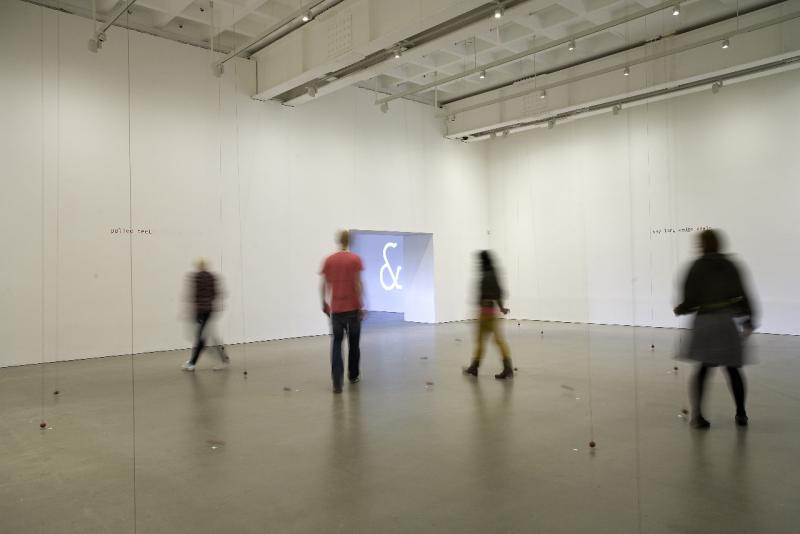 View of “Alpabet” and “For Walls” in Arnolfini Gallery 3, Bristol. Photo by Jamie Woodley.
View of “Alpabet” and “For Walls” in Arnolfini Gallery 3, Bristol. Photo by Jamie Woodley.
Rudy: Even though you started on this path by working with a photographer, your work doesn’t actually engage with images, does it!
Bergvall: Very interesting point. I suppose I do work with language graphically on the page and across the pages, and also visually and spatially when on a site or on walls. But yes, I haven’t worked much with nonverbal images as such. Although I would argue that the spatial trajectory built to guide the viewer/listener through the Say Parsley show, the twenty-five hanging plumb lines, for instance, do create a mobile image, a sculptural instance that one accesses kinetically and visually. Also the seen/unseen vinyl lettering on the walls creates a perceptual image, one that changes as the reader walks closer to the display. For my upcoming show at the John Hansard Gallery. [2] I am working with the historic broadside ballad, which of course would always have had illustrations alongside the text and so here you see a move towards a more conventional and illustrative use of image alongside text.
Rudy: I’d love to hear more about that project.
Bergvall: I’ve been commissioned to do a piece for the John Hansard Gallery at the University of Southampton. The show opened in September [2010]. The John Hansard is a very good, internationalist, regional gallery. It has a solid reputation for being quite intellectual, and they’re very broad when it comes to the media they’re interested in. They haven’t done a writing show in this way before. So they invited me to do a new piece of mine.
Rudy: And what’s the piece called?
Bergvall: It’s called “Middling English.” [3]

First page of Bergvall’s Alyson Singes (2008).
Rudy: Is it the same “Middling English” referenced in the latest iteration of Say Parsley at the Arnolfini Gallery in Bristol?
Bergvall: Yes. That quote is adapted from a piece of the same name.
Rudy: So tell me about “Middling English,” then. Is it a critical essay?
Bergvall: It has become a sort of template of thoughts and methods behind the John Hansard project. More largely, it supports my writing as a whole at the moment. I’ve been writing this piece for the past year or so. The final version of it is forthcoming in my collection of selected texts, Meddle English, which has just appeared. It wants to be polemical and starts really by saying, let’s think about the medium of English. It has Middle English as a starting point.
Rudy: Is it related to your Chaucer work, then? To Alyson Singes, for example?
Bergvall: Yes, its starting point was the Chaucer work. But it’s also working its way to reflecting on other hybridized language use, and what I consider to be the role of the writer today. It explores the residues from the past contained by language. It then looks at a language in full transformation, Middle English, at the beginning of its own identity as a compound of French, Latin and Anglo-Saxon, etc., and ends up speculating about the Englishes of today, again in full flux, after a long historical period of domination — also linguistic domination, by way of trade notably, and colonial politics of dominance and occupation. So I’m interested in thinking about the various horizons of English, what kind of language is there, what kind of world is it signaling now, what is coming after it.
Rudy: That’s so interesting. You were talking at lunch about seeing yourself as a writer of the future. Can you speak a bit more about that?
Bergvall: What I meant was twofold. Mainly that I am not an artist but I am not exclusively a literary writer either, and I work as a writer in spaces usually dedicated to visual or sound artists. I need the spaces these artists occupy for my work with language and writing. It is quite pragmatic. Formally, this combined compositional and presentation focus of textuality and spatiality is in the lineage of [Marcel] Broodthaers, who in turn was working out Mallarmé’s influence on him. The future of the book has in more than one respect become sited writing, networked writing. I also meant that my approach to language as a complex, historically charged, culturally multilingual and politically postnational system is reflexive of a citizenship that does not yet exist or is not allowed to exist within current parameters of identity and belonging. The future here is idealistic, as much as dystopic.
Rudy: Can you speak a bit more about how you, as an artist, need the spaces that artists occupy?
Bergvall: As a writer-artist, I need other spaces as well as printed spaces. And I was also signaling the future because we’re still very constrained by ideas about publishing. I love getting published, but I also function in spaces that signal another time of work, another catapult, another way of thinking about commissions, another way of thinking about what it means to be working in language. It’s complicated: poets have a way of commanding language that is very different from artists. Artists often have a reductive or programmatic attitude to using language, and don’t quite relate to the many subtle, semiotic ways in which language operates. But they often show far more acumen about how to let the language be worked by a site. It’s really exciting because for all the precedents in the visual arts and the historic avant-gardes, this extrapolation of more complex forms of verbal work and textuality into spatial audiovisuality is still in germination. People like Arnold Dreyblatt, Christof Migone, Imogen Stidworthy, and other artists who use a combination of language and audiovisual technologies are very inspiring to me. At lunch you were talking about Erín Moure. Like Susan Howe’s work, Erín’s work has a very radical presentation on the page. The page becomes a meeting point of past and present. For instance, her scans of sewn texts in O Cadoiro complicate the textual reading of translation by resorting to both ancient (the sewing, the textile) and digital traces of activity and composition. This is how she chooses to re-present contemporary translational traffic, as the locked hands of different technological physicalities and temporalities. And then there are writers who don’t feel that print is necessarily the focus of their writerly activities anyway and work increasingly outside it.
Rudy: You also need so many more resources to publish outside of the page or the book.
Bergvall: Yes, but you’re a very different kind of animal when you compose for a gallery. At the moment, I run a project where I have a project manager and a technical team. When a project really gets going you can spend so much time on these aspects. For example, how the John Hansard project evolves will have a lot to do with the collaborators’ own brief, the ideas they have. Very little at that point has to do with writing. But it is all leading to the inscription of linguistic activities. I love the conversations, the tensions, the pragmatic demands. For the John Hansard, I was initially thinking about sound and architecture. So I invited an architect to work with me. After that it is a question of rethinking what I want to say with language architecturally. I have been finding Gordon Matta-Clark’s photographic work very interesting in this respect, his complex architectural descents, his distortion of perspective, and then also his love of truffles as methodology: treasure is in the muck. I want to use this to stage various depths and surfaces of language use in the new show.
Rudy: I’m still thinking about what it means that there are no visual representations in your work. At the Say Parsley exhibition in Bristol, for example, going into that space, it felt like walking into the Lacanian “real” with this alphabet on the floor, every letter but ‘h’ appearing in white vinyl lettering under a plumb line weighted down by a shiny red (read?) ball. At first I didn’t see the letters, but once you start pushing the lines and knocking the balls together, the letters are suddenly visible. It felt like this incredibly spare and yet absolutely full space of the continuum of the signified.
Alpabet
constellation of 25 plumb weights / white vinyl lettering /badge
The alphabet has 25 letters. We dropped one letter. Take it with you on the way out.
The ‘h’ is a troubled letter in English. Whether it is pronounced or not carries with it strong social markers. The dropping of the (h)aitch has for centuries stigmatized or located the speaker. The varying pronunciation of the letter ‘h’ can still be political. In the Irish language, the ‘h’ is very powerful. Its inclusion or omission along with its effect on pronunciation are often primary indicators of regional dialect The ‘h’ is heard as shibboleth.
Section three of Say Parsley, installed in Arnolfini Gallery 3. Note the missing ‘h’ in the title “Alpabet.”
Bergvall: Yes, that’s right. And the alphabetic language is experienced as such, letters on the floor, yet also at a remove, through the movements of the hanging plumb lines, in a sense.
Rudy: So many linkages are opened up, and there is such slippage and play. Do you see Say Parsley as a piece that explores semiotics?
Bergvall: What interested me with this particular project was ideas of perception. And how language perception and the creation of meaning is indeed activated by various codes. Because I was working with my collaborator, the composer Ciarán Maher, it very much had to do with language as sound heard, as much as language and meaning misheard. But in a sense this accumulation of mishearings both as sound source and verbal sense rest on similar issues of semiotics. This has to do with identifying features of sense and realizing how these verbal permutations also come about as sound formants and as microparticles of language, and this is what creates or enables so much rich confusion in the listening process. And then there was this idea of listening on the move. How the positioning of the listener was crucial to the experience of the piece. That was the starting point of the piece. That and my exploration of the power and violence of the shibboleth. So the whole installation is very grounded in various aspects of semiotics, active, social manifestations of language, of verbal understanding alongside somatic experiences of language, and poetic emphasis, in the Jakobsonian sense. So it starts with language mired in the social world of communication. And it’s coming at language as a physical value inside of you. What was important for me here is the way that language can be so physically imprisoning.
Speakers
Stereo speaker pair
The complex tones of the speaking human voice are transformed into simple waves. At these frequencies, speech can also echo the patterns of birdsong.
Section two of Say Parsley, installed with “Ampers&” in Arnolfini Gallery 2.
Rudy: The tension between the fact that by its nature language offers the opportunity for so much openness while particular language systems — social systems — shut down the possibilities of meaning rather than opening them up.
Bergvall: Yes. Say Parsley is really about how speaking and meaning are really a prison, how language is something that inhabits and becomes forbidding. So in that piece it’s not so much about the slide of the signifier in favor of the playfulness. It comes really out of the violence of identification; it’s really didactic.
Parsely
Data projection / 2 suspended speakers
Standing under a speaker, the listener can hear a list of words that runs from “Pig” to “Parsley” through small phonemic shifts and syllabic variants. The list on the wall reproduces visually the words heard as they would look in two of the languages that have influenced the development of English (Dutch and French).
Section five of Say Parsley, installed in Arnolfini Gallery 4.
Rudy: It begins with the hideous fact that at a certain moment in history saying, in the sense of pronouncing, the word “parsley” in a particular way could get you killed. The background information about Say Parsleyon the Arnolfini Gallery website tell us that “the most recent example of a large-scale shibboleth was the massacre of tens of thousands of Creole Haitians on the border of the Dominican Republic in 1937, when the criteria for execution was the failure to pronounce “perejil” (parsley) in the accepted Spanish manner, with a rolling r.
Bergvall: Yes. Say Parsley started with the need for testimony because it was done in the months after 9/11. The first version was produced for a show in Exeter in November 2001. And I was getting really freaked out about the kinds of things that were being said and done, both in Britain and in the United States, what was happening in relation to nationals and residents, and how this witch hunting was building up of those who are not the right kind of residents or even citizens. This was really horrific. And so the piece is very much in response to the realization that at any point your way of speaking or living can come and haunt you and single you out negatively. The piece is very much exploring and reminding of this violence and how it is inhabiting us, and how we could be made victims of that, or become the perpetrators, through intolerance and lack of genuine listening. There’s been a lot of that here recently with Eastern European nationals coming here to work with their very strong accents and their initially imperfect command of English. Quite apart from the obligatory outcries about jobs and social services, this has actually been creating grating at a much deeper level, that of the connection between verbal fluency and social fluency.
Rudy: There’s no question that the social is foregrounded from the moment you enter the gallery space and see the excerpt from “Middling English” that is inscribed in vinyl on the wall.
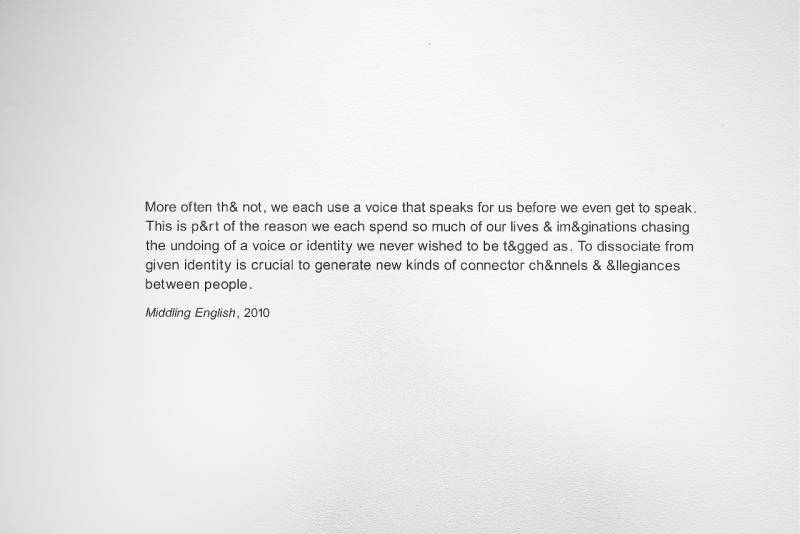 Prose text selected and adapted from Bergvall’s critical piece “Middling English” on a wall in the “Ampers&” section of Say Parsley, Arnolfini Gallery, Bristol. Photo by Jamie Woodley.
Prose text selected and adapted from Bergvall’s critical piece “Middling English” on a wall in the “Ampers&” section of Say Parsley, Arnolfini Gallery, Bristol. Photo by Jamie Woodley.
Rudy: My experience of the Say Parsley exhibition was completely framed by this reminder that “we each use a voice that speaks for us before we even get to speak.”
Bergvall: Yes. And then you move into the whole idea of verbal permutations, and you move into slowly building it up, from the alphabet, and then of course you move into the poetic.
Rudy: But the ability of the spectator to read the textualized space like a poem is crucial. Even the titles of the five sections of Say Parsley [“Ampers&,” “Speakers,” “Alpabet,” “For Walls,” and “Parsely” are so rich with meaning. Section one, “Ampers&,” includes and exemplifies the several uses of the visual/graphic sign it investigates — the & — in the title itself. In the exhibition guide you tell us: “The ampersand is one of the oldest exclusively visual/graphic signs of the western writing system. In its contemporary sense, it binds elements together and words as an additive device. In its medieval sense, it is a shorthand, used by copyists to speed up the endlines of words, such as ‘aspir&,’ ‘differ&.” And the piece “For Walls” consists of vinyl lettering on four walls.
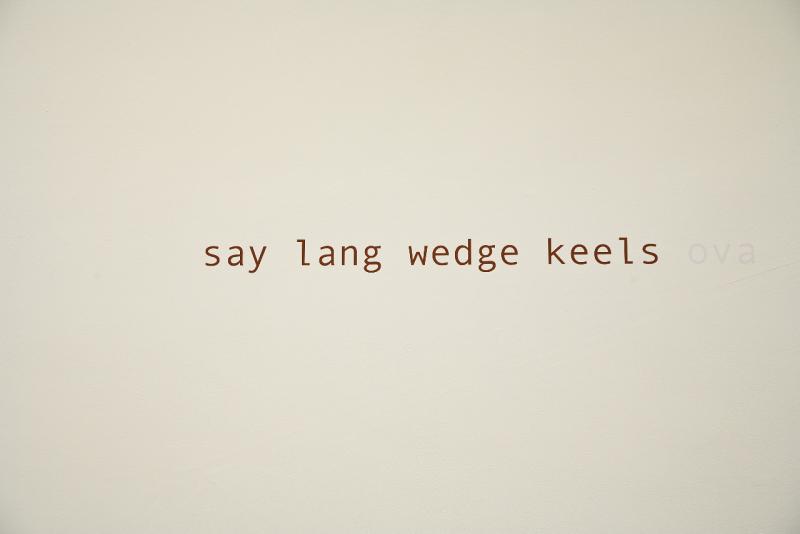 Text on one of the four walls in the “For Walls” section of Say Parsley, Arnolfini Gallery 3. Photo by Jamie Woodley.
Text on one of the four walls in the “For Walls” section of Say Parsley, Arnolfini Gallery 3. Photo by Jamie Woodley.
Rudy: As I was standing in the gallery space, I was in a kind of documenting mode, so I wrote down the letters that I saw on one of the walls. But that didn’t make any sense to me: “lang wedge keels.” And it did feel like I was writing down letters, not words. I didn’t recognize these groupings of letters as words. It wasn’t until I was reading through my notes in preparation to speak with you that I put these letters into my mouth and heard myself saying a word, that is to say, making a meaningful sound. Once I heard sounds that made sense to me, I wrote in my notebook words that make sense: “Say language kills.”
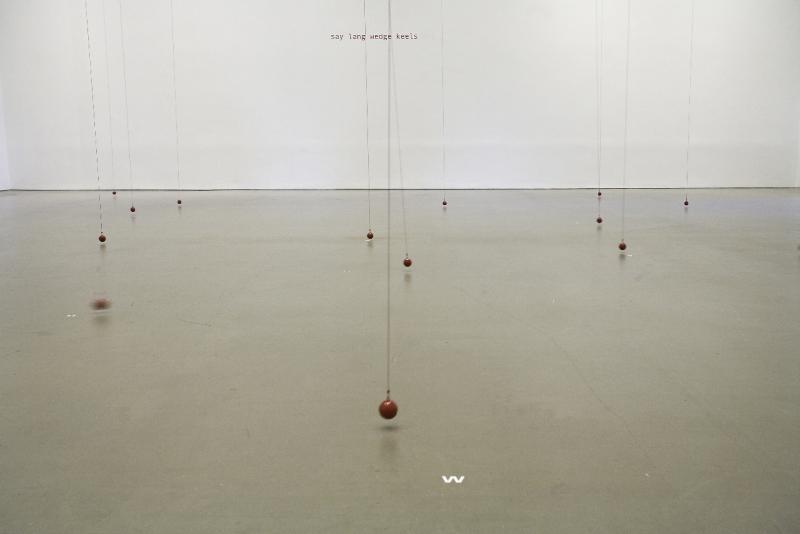 “For Walls” consists of vinyl lettering on four walls.
“For Walls” consists of vinyl lettering on four walls.
Bergvall: But you didn’t notice the word “over”? Did you see that?
Rudy: [Looks through her notebook.] I recall writing down some letters that couldn’t be photographed because they were in shadow, letters that were the same color as the walls — yes, I have written in my notebook the letters “ova” which appear under “keels” on the wall.
Bergvall: But you didn’t see the word “over”?
Rudy: No! Ah! I “see” now, now that I’ve heard you “say” the word “over” — I “see” “over” in “ova.” But what I saw and heard at the time was only “ova”! Right, language not only kills; it also “keels over”!
Bergvall: So that’s why you have the poetic coming in more as pronunciation, and it asks for the double take.
Rudy: Thinking about the double take makes me wonder what the word “middling” might signify. When I first saw that word in the title of the piece cited in the gallery, I thought about your work generally and about how much you like to explore middle spaces. And I know that “hybridity” is not a very useful term. But can you talk a bit more about your invention of that word “middling”?
Bergvall: Yes, but I’d like to think about it in terms of hyphenation. In my chapbook Cropper, which I gave you last year, for example, there’s that sense of wanting to just skip the hyphenation, remove the doubleness. One notion of the hyphen, of the hybrid too, to some extent, has so much to do with contemporary politics, with ideas of collective or singular migration, or migrancy, willed or unwilled — when you move to another country, the sense that you have to change your language, change your being. It remains a very powerful trope for me, particularly as it relates to my sexuality, since this is what kind of propelled me into English. But I’ve often thought about it as a process of invention. A conscious language acquisition process is obviously very different from the languages learnt as one grows up. I know that as a young gay woman I was being defined, often negatively, by others, and this means that processing language with pleasure for me became very connected to a necessary physical act of verbal distancing from home languages, and eventually physical migration. Responses to my sexuality were the main reasons why I moved both myself and my language’s work into English.
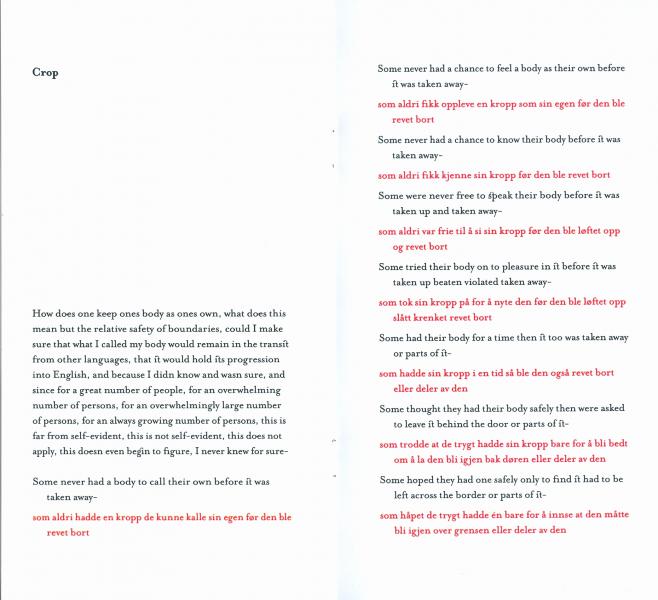 From Bergvall’s Cropper (2008).
From Bergvall’s Cropper (2008).
Rudy: That’s fascinating; tell me more.
Bergvall: I really have always sort of felt that notions of hybridity have to do with enforced identification, just as much as with pro-active identity claim. In the 1990s, the notion of queer aesthetics as a radicalizing pastiche, a hybrid collage was very strong and I thought very relevant. It presents itself as a warped mirror talking back at identity and the identificatory strategies of power. The solution proposed was a mixture of pop, technology and politics, very much in fact in line with Bakhtinian thought. His ideas around engaged heteroglossia in the face of political stiltedness or monumentalism. Carnival as obstacle and refusal, as a breakdown through material forms. I find it a very convincing way of approaching writing in its relation to cultural politics. And identity becomes then about reading one’s own aesthetic premises in the contexts of social and political stratifications. This lack of ownership, of fixity to one’s process and thought can be very elastic. It gives an overview. It leads to processes of explicit intercoding, and asks what performative interrelations really can be about. Separating the idea of hybridity from the fake liberatory and dangerously homogenizing politics of global multiculturalism has of course been crucial to many artists and scholars.
There’s a point at which you start to produce your own artistic language in the new cultural context. You start infiltrating it with what else also comes with you, the other worlds or specificities that allow you to inflect your language use. Personally, it gives me a way to rethink myself within and beyond the Anglophonic cultures I’m now in. This whole idea of the middle is always a trajectory, a transit, the possibility of invention that we find ourselves in, conscious and unconscious.
Rudy: It seems significant that you’ve framed this being in the middle as an active verb. You are doing something; you are “middling” English.
Bergvall: Yes, to think about “other” as a verb, as Nathaniel Mackey famously does, that is very powerful. But I think also a lot a lot about Édouard Glissant’s Poetics of Relation. We were talking about that at lunch. When it comes to gender and sexuality, he is completely silent, but he is fascinating in relation to rethinking geography, historic and utopian space, beyond the middle passage, and slavery, this horrible, traumatic time-place of absolute darkness, of absolute loss, of names, languages being forced out. And you have this culture of the Caribbean that he and other writers have helped to create linguistically, poetically, as well as physically, through survival and invention and the making of the politics of the islands. But it is more than islander autonomy he looks for. As he says, Caribbean creolization becomes an example for the future. What happens in Caribbean creolity is rescuing the present from the horrors of the past and shaping an idea of the future beyond western universalism and internationalism. He also has a beautiful, utopian way of writing. Much like Nicole Brossard. And at the moment, it seems to me that I really just need that kind of imagination, that kind of optimistic belief in language, the engagement with it as a polemic as much as a poetic tool. It provides a way to think beyond the given parameters of the present. It shifts the temporal significance away from the exclusive, and I think, ultimately dangerous supremacy of the now that we have seen so much in art and poetics.
Rudy: Yes, absolutely.
Bergvall: So I love his language as much as his politics. He allies history, impossible memory, with the idea of the future, with a language practice very much rooted in the present of political and cultural reality. How can one then create a language practice that can adapt itself to mixed cultures, to mixed geographic fates, and shift the ideological premise of western control. All of that for me is part of the hybrid, the compound, the ampersandic.
Rudy: Can we talk a bit more about your “Via” piece?
Bergvall: Yes, of course. The ampersand is part of “Via,” in the sense of the instability of the translation and of the original. But first, Glissant talks about defolklorization, not sentimentalizing a starting point, not sentimentalizing a point of no return to a culture of origin, being critical of one’s own sentimentality and one’s sentimental needs. Really for me this is a very important idea, this concept of resisting identity and yet having somehow to claim it. I don’t want to claim queer identity for my work necessarily. But I do want to be able to examine the terms that I can use in my work and that are specific to myself, and a number of others, so that I can use in language and in culture such points of separation and of community, what constitutes community.
Rudy: But that’s so tricky. I was reading your notes on your “About Face” piece (“Piece in Progress: About Face”), and you talk there about your own contradictions and tensions, and you ask yourself the question “How deep is the bride?” and I was thinking about that word “bride” obviously as a figure in English but also about how the word “bride” in French means “bridle” and how, since I saw Say Parsley, I’m aware of not being sure of which system of signification we’re operating within (French? English?). I assume you mean both of them.
Bergvall: That’s right, yes.
Rudy: And I take it the question you’re asking is about how deeply these ideological patterns are embedded in us, and asking what we can do to get rid of them, or not, or embrace them, or break them?
Bergvall: Absolutely, yes.
Rudy: Which makes me think again of Say Parsley. Can we close this conversation by talking a bit more about the history of the construction of that piece? It was created in 2001?
Bergvall: Yes, the first siting of this collaborative sound-language installation, then called “Say: ‘Parsley,’” was in November 2001 for the Spacex Gallery at the Exeter Maritime Museum.
Rudy: What kind of space was it created for in Exeter?
Bergvall: The Maritime Museum was a beautiful space, two floors, and it was abandoned, it was supposed to be demolished; now it has been transformed into apartments.
Rudy: And you had two floors for the installation?
Bergvall: Yes, we had the poem chalked on the wall downstairs, interviews, people speaking upstairs, the plumb line grid, a set of pairings that weren’t in Bristol, an audio text in the corner. And you had the lists and the letterings and the plumb lines moving. And the three white r’s in the distance.
Rudy: Did you include the piece called “Speakers” in that first installation?
Bergvall: The one that sounds like birds?
Rudy: Yes.
Bergvall: That wasn’t in the first installation.
Rudy: Was “Ampersand” in the first version of Say Parsley?
Bergvall: “Ampersand” was its own datapiece that I then put in a show I was sharing with Ciarán at the Bury TEXT festival in 2004. But that’s a piece that I’ve carried on my own.
Rudy: So it looked much different from the one I just saw in Bristol.
Bergvall: Yes, very, very different.
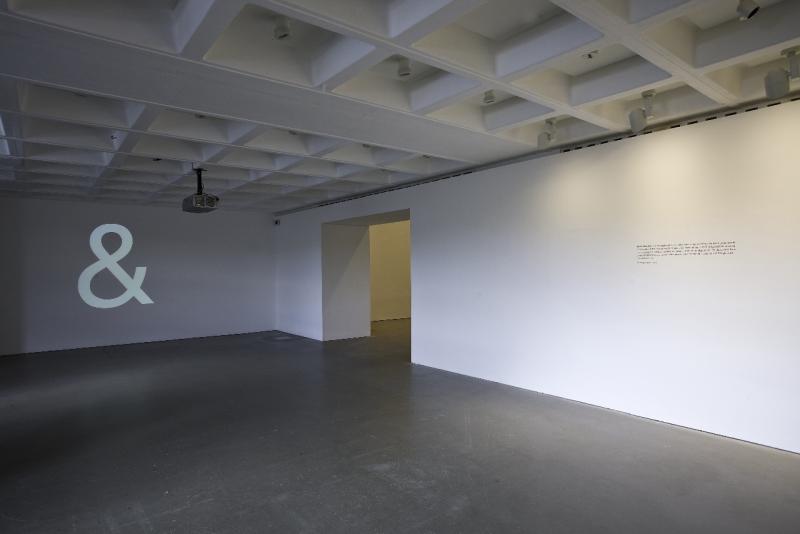 One of sixty-four ampersands found in a computer font library and projected onto the wall in Arnolfini Gallery 2. The small text on the right wall is from “Middling English.” Photo by Jamie Woodley.
One of sixty-four ampersands found in a computer font library and projected onto the wall in Arnolfini Gallery 2. The small text on the right wall is from “Middling English.” Photo by Jamie Woodley.
Rudy: What struck me was how powerfully the ampersands function as signs when they are so massive. They were projected on a large white wall and took up the entire space. And when you stand there looking up at so many of them that they start to take on shapes, representations, figurations, because they take up so much space on the wall. They started to look like girls to me.
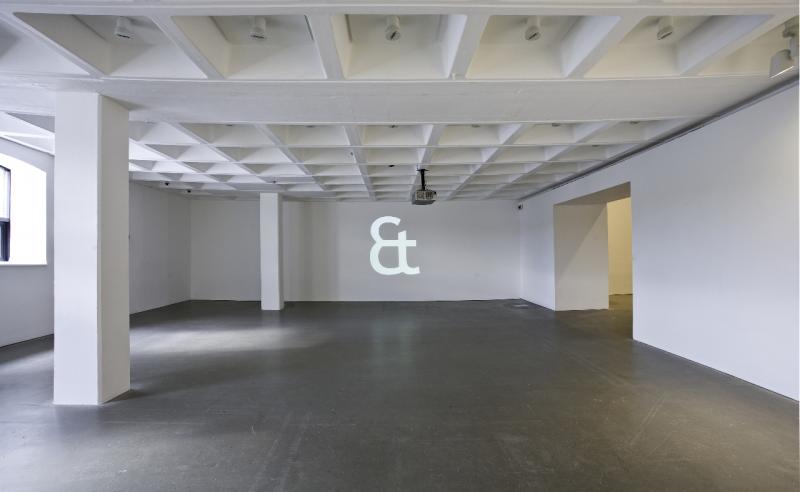
Another of the sixty-four ampersands found in a computer font library and projected onto the wall in Arnolfini Gallery 2. Photo by Jamie Woodley.
Bergvall: I’ve never gendered it actually but … it’s really sort of ironic, it’s a very anthropomorphic sign.
Rudy: And the piece “For Walls” — was that in the 2001 version of Say Parsley?
Bergvall: No, that’s completely new.
Rudy: So the Bristol version is really a completely different piece then.
Bergvall: No, it’s the same.
Rudy: Tell me about how it’s the same when it’s made up of such different pieces?
Bergvall: Well it’s about how the piece fits the space, for one thing. And of course the time that elapses between iterations. And the pursuit of the question.
Rudy: What’s the function of the letter ‘h’ buttons that you can pick up from the box in the gallery and take away with you?
Bergvall: That’s about dropping the ‘h.’ That’s just a game. And it’s also — it might be ‘h’ in general. You know each letter has a history, in some way. It’s one of those fascinating letters in English because it’s a letter that has a whole set of imported French words attached to it. In the romance period, sort of late medieval period, you have coming into English vocabulary a lot of French words. Where the ‘h’ is not pronounced — “honor,” for example. So there’s a whole sense of a letter being important for the fact that it’s not pronounced. And then of course it’s also about social class and stigmatized speech. So ‘h’ is just one of those fascinating letters. It carried so much charge for English, like what ‘r’ carries for the Creole/French. I put it in because although it may not have led to what was explicitly collective violence it certainly has led to persistent kinds of exclusion. There’s still a real snobbery here about speaking the ‘h’ or not speaking the ‘h,’ so that’s why that’s there — and to have that as a sort of badge. And then you can consider it as this lovely abstract figure too. It makes me think of the I Ching.
Rudy: And what about the plumb lines? What were you thinking about there?
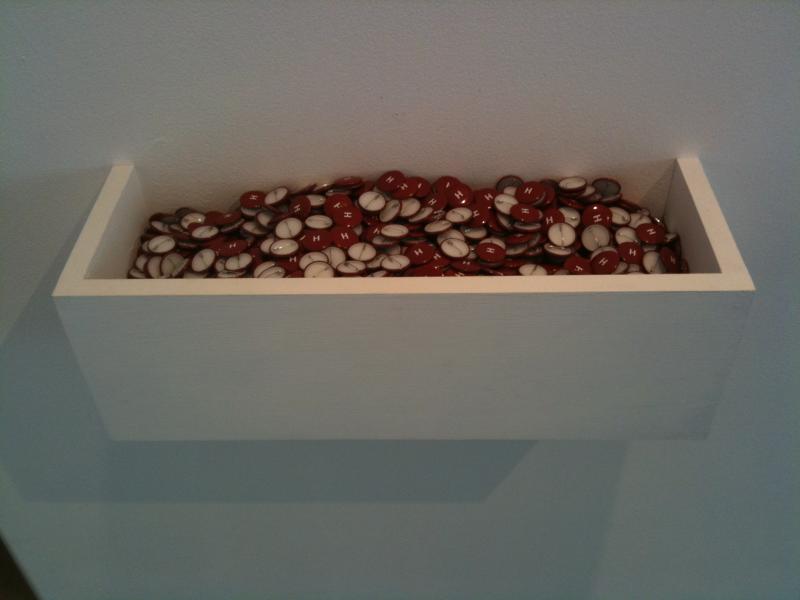
Bergvall: I’m using that again in the John Hansard show but in a very different way. I think about it in relation to pendular movement. But then somebody was telling me that really what one wants with the plumb line is for it to be still, for it to carry its weight.
Rudy: I wanted to go around the room and put them all in motion so that they were hitting each other.
Bergvall: Exactly — if you have something you can make with movement, you should. That’s part of what I’m saying with the work, the Freudian fort/da, the always moving, the to and fro, the yes/no, a reminder that everything moves on both sides of the hyphen as well. Spatial work that you have to walk around. And I was interested in the weights themselves, in a logic of weight. And of course we were in the Maritime Museum initially. This is a very strong trait with naval history. Somebody was telling me the other day that for them the plumb lines felt like demolition balls into language.
Rudy: In speaking with you I realize that when I experienced the Say Parsley show, I couldn’t help but think about the piece as though it were a long poem. Moreover, I imagined that what I was seeing was a particular edition of a long poem that had earlier versions. But I realize now that it’s a very different thing when it moves into a different space.
Bergvall: It is a different thing. But linguistically it is crucial to me that you remain very close to the material, to the linguistic system, because it started with the rolling r, with the phoneme, so you have to start with pronunciation and then start with the fact that you’re dealing with sounds which are part of a permutational system. Some of the things kinetically are there because they can be — you can move around the room, move the weights, have a look at the transparencies, the lettering on the wall. Which you can do on the page too. But it’s different to be there with your full body. It is in a poetic mode. But if it asks to be taken on as literature, it asks of literature that it move with us. When you said to me that you wanted to talk about the work I was so pleased, because I know that you are a literary scholar and so there really is this pleasure in my wanting to talk with you about the work instead of it always sitting inside a visual arts world. Because this is really where the work needs to take place. So that leads back to what we said about the future, and it’s actually a way of saying that we need other platforms on which to do poetic work.
Rudy: And that’s what I loved about the piece, because it was like being inside a long poem, and being able to walk around and inhabit it.
Bergvall: That’s wonderful. Thanks, Susan.
1. This conversation was initiated by Susan Rudy after she experienced the most recent iteration of Say Parsley at the Arnolfini Gallery in Bristol, UK. The show ran from May 8 to July 2010; the exhibition guide can be downloaded here.
2. Entitled “Caroline Bergvall: Middling English,” the show ran September 7–October 23, 2010, at the John Hansard Gallery.
3. From the John Hansard Gallery website: “‘Middling English’ explores some of the pleasures and complexities of language use, in and through writing. The exhibition brings together multi-sensory elements — spoken pieces, audiophonic compositions, printed broadsides and the strange memory world of pop lyrics — all presented through a stunning architectural installation.”
Works Cited
Bergvall, Caroline. Alyson Singes. New York: Belladonna, 2008.
———. Cropper. Southampton: Torque, 2008.
———. Éclat sites 1–10. ububook, 2004.
———. Fig. Goan Atom 2. Cambridge: Salt, 2005.
———. Goan Atom. 1. Doll. San Francisco: Krupskaya, 2001.
———. Meddle English: New and Selected Texts. New York: Nightboat, 2011.
———. “Piece in Progress: About Face (Goan Atom, 2).” How2 1, no. 6 (2001).
Glissant, Édouard. Poetics of Relation. Translated by Betsy Wing. Ann Arbor: University of Michigan Press, 1997.
Mackey, Nathaniel. Discrepant Engagement: Dissonance, Cross-culturality and Experimental Writing. Cambridge: Cambridge University Press, 1993.
Moure, Erín. O Cadoiro: Poems. Toronto: Anansi, 2007.